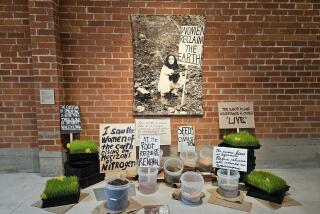ART REVIEW : ‘Gardens’ Show: Both Fertile and Dry : Art: A variety of ideas take root in the works of 12 artists on exhibit in Escondido.
- Share via
SAN DIEGO — “Gardens: Real & Imagined” feels a bit untended--overgrown and ambitious in parts, stunted and parched in others. The Bernice Steinbaum Gallery in New York, which originated the show last year, invited 12 artists to explore the garden as idea, metaphor or literal plot of land. The results can now be seen at the Felicita Foundation for the Arts in Escondido (247 S. Kalmia St., through Feb. 1), the show’s sixth stop on a three-year tour.
“The artists chose not to deal with the physical qualities that create the promise of a garden--the shapes of land and water, the established plant or the young sapling, the light and wind, the climate--instead they pay particular attention to the rituals of habitation by which we take possession of places in our minds,” says Steinbaum in the show’s catalogue.
A few of the artists do, in fact, address the natural landscape, but theirs are the most lackluster works in the show. The strongest paintings and sculptures are those that stray furthest from literal interpretations of the garden theme to venture into acute social commentary. Robert Colescott’s painting, “Garden Spot,” and Luis Jimenez’s fiberglass sculpture, “Cruzando El Rio Bravo (Crossing the Rio Bravo),” shine here with an intensity that has little to do with plants and trees but can easily be read in terms of paradise--lost, found and aspired to on Earth.
Colescott’s striking, disturbing vision of inter- and intra-racial tension is framed with a border of one-dollar bills. Money buys paradise in this world, and the black couple in the center of the image have made their purchase. In bikini and swimming trunks, they stride toward a pleasant beach. He carries a blanket, a beer and a cordless phone.
They may be living the American dream, but a nightmare of violence and despair surrounds them. In one corner, a white man aims a gun at a target painted on a black man’s back; in another, a black face looks up plaintively at the perfect couple from a trash heap of old tires, cans and shoes. Nearby, a white man who looks suspiciously like Richard Nixon paws at a nude black woman. Opposite them, a young black man stands poised to shoot a basketball.
Colescott’s message is mixed, his gaze troubled. Violence, poverty and other forms of societal abuse make this country a thorny garden, indeed, for blacks. Couched in a satirical, nearly caricatured painting style, the terrors still feel pungent and profound.
In Jimenez’s work, monumental figures embark on a “Flight From the Garden,” as the painted backdrop behind them proclaims. They stand, all three of them, on only two feet, those of the strong and stoic father who carries his wife and child across the river, across the border to a new country and a new life.
More than 10-feet tall, this glistening tower of determination pulsates with honesty and humanity. Feet are bare, muscles are taut and the baby cries as the family proceeds on its tense, promising journey. As Jimenez suggests, this flight from the garden of Latin America may bring material well-being, but it means a desertion of native culture and native land. The expulsion is voluntary, but bitter, deeply rooted forces encourage it.
The link between Colescott’s work, Jimenez’s and the rest of the show is subtle but, on the surface, quite tenuous. “Gardens: Real & Imagined” also contains the fresh, engaging visions of Italo Scanga, Joyce Kozloff, Roy DeForest, Miriam Schapiro and others. Many summon up notions of the garden as the ideal of purity or, conversely, the sullied swamp of contemporary culture. Few, however, evoke these themes as powerfully as Colescott and Jimenez.
More to Read
The biggest entertainment stories
Get our big stories about Hollywood, film, television, music, arts, culture and more right in your inbox as soon as they publish.
You may occasionally receive promotional content from the Los Angeles Times.










